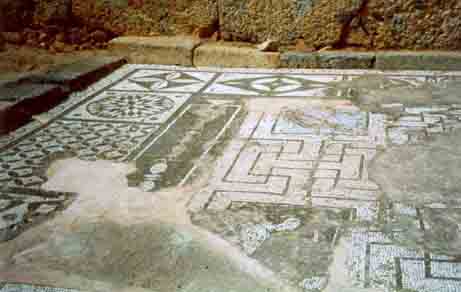

|
ARCHEOLOGICAL SITES The whole of Crete is like a big history book. In many areas around Paleohora there were many towns, especially during the Hellenic Period (400 BC), controlling the surrounding villages. Those towns were quite big as they were situated in the mountains and gave shelter against robbing pirates. LISSOS Near Paleohora, to the east, the ruins of the ancient powerful and independent city of Lissos are to be found. ELYROS The most important Dorian city of ancient Western Crete, which had the ports of Sougia and Lissos under its control, arose from the 4th century BC until the 5th century AD. The independent and autonomic trade and agriculture city with its own currency was destroyed in 823 by the Saracens and is mentioned in the opus' of Pausanias, Skylakas Ierokles and other travelling authors. Significant finds are displayed in the archeological museum of Chania. KADROS Very imposing ancient ruins are found in the little mountain village of Kadros. The town existed from the 4th century BC until the 10th century AD. It conveys the picture of a big town with quite a big population. The graveyard with tombs engraved into the rocks is very interesting. The most important and best known town in the valley of Vlithias was Kandanos or Kandania with copper and quartz mines, which can still be seen today. There are quite a variety of finds: an epigraph dedicated to the emperor Traiano, a part of the statuette of Septimos Sevyros, parts of locks made of copper and lead and a lot of other objects. Also worth mentioning are the relics of the town defense facilities like walls and towers in Anydroi and Spaniakos as well as the grave monuments of the early Christian period with their beautiful mosaics. YRTAKINA was an ancient town above Platanos. Relics from late Minoan periods were found there. SYIA is the now called Sougia and arose during the Roman period. You can still see relics and ruins of town walls, aqueducts and Roman spas. PELKIS Ancient town of Pelekanos, fundaments of antique walls and relicts of the graveyard. KALAMYDI The exact position of this town is stillnot yet known. Travelling authors in the 19th century insisted that Paleohora was built on the ruins of Kalamydi. TARRAS is the now called Agia Roumeli. It is the home of the nymph Akakallida who had an relationship with Apollo and gave birth to Filakides and Filandros, the roots of the Elyrians. VIENA was an ancient town situated west of Koundoura. Antique marble column can still be seen in the small shallow bay. POIKILASSOS was one of the 100 ancient cities during the Hellenic period, and it was the port of Elyros. There was the temple of the Babylonian god Sarapis who was the "wise leader of mankind", "king of the ocean" and "sovereign of the earth". Ptolemeus mentioed him in his opus "Geographica". |
© SCI 2003 - 20XX // all rights reserved
 It was the port town of the ancient cities Yrtakina and Elyros. Lissos was a big center of trade and had its own currency, which was carved in gold. The ancient geographer Skylakas mentioned it in his opus "The circumnavigation" in 350 BC. It is quite a big area in the bay of Agios Kyrkos. A lot of ceramics and other objects from the classical Hellenic-Roman period as well as from the Byzantine are still lying around there. Ruins of the antique theater, the Nympheon, the Dorian temple of Asklepios with its beautiful mosaic floors, cisterns and port facilities remind one of its once old magnificence.
It was the port town of the ancient cities Yrtakina and Elyros. Lissos was a big center of trade and had its own currency, which was carved in gold. The ancient geographer Skylakas mentioned it in his opus "The circumnavigation" in 350 BC. It is quite a big area in the bay of Agios Kyrkos. A lot of ceramics and other objects from the classical Hellenic-Roman period as well as from the Byzantine are still lying around there. Ruins of the antique theater, the Nympheon, the Dorian temple of Asklepios with its beautiful mosaic floors, cisterns and port facilities remind one of its once old magnificence.